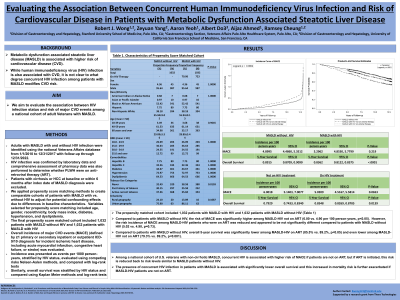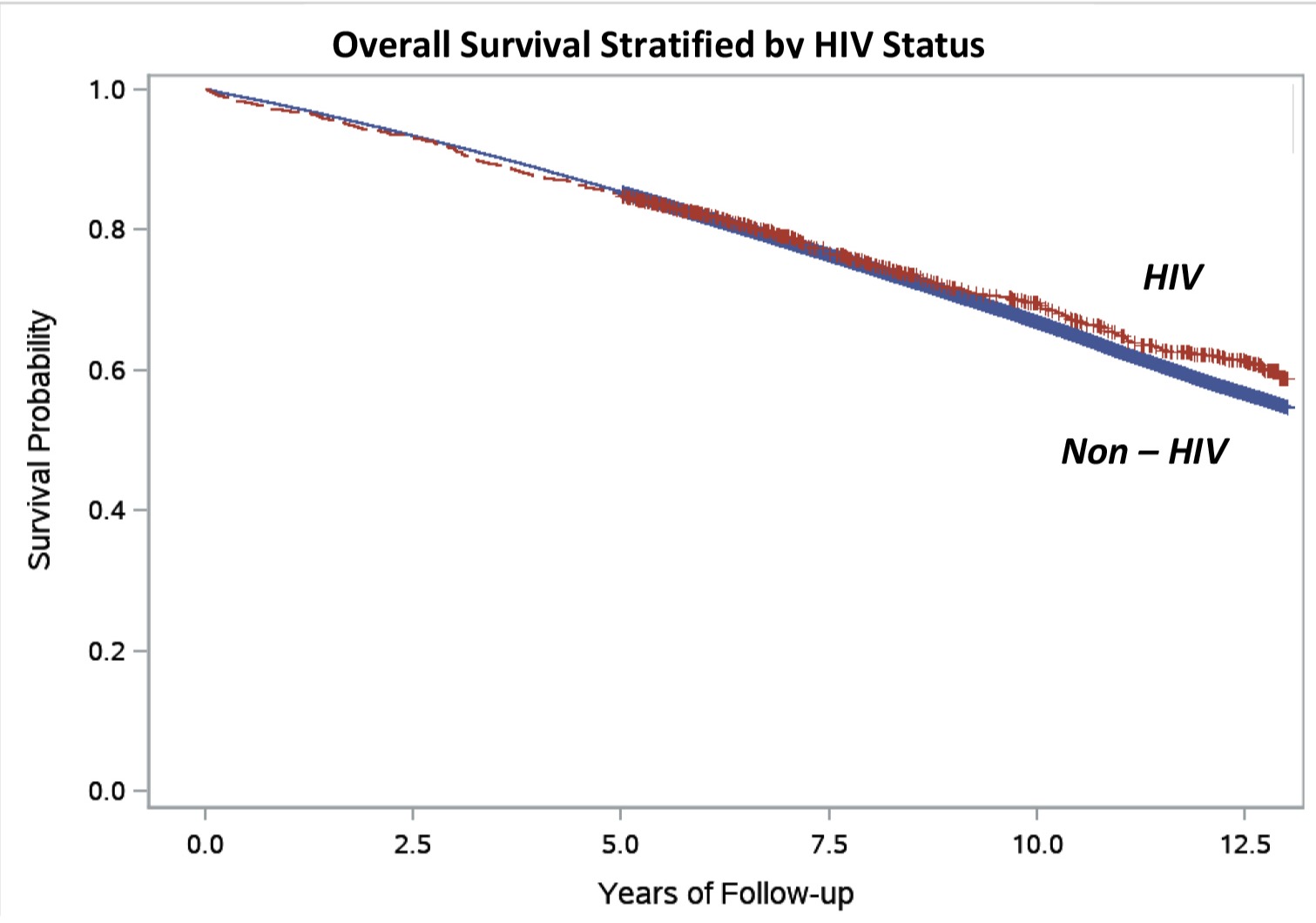Sunday Poster Session
Category: Liver
P0937 - Evaluating the Association Between Concurrent Human Immunodeficiency Virus Infection and Risk of Cardiovascular Disease in Patients With Metabolic Dysfunction-Associated Fatty Liver Disease
Sunday, October 22, 2023
3:30 PM - 7:00 PM PT
Location: Exhibit Hall

Has Audio

Robert J. Wong, MD, MS, FACG
Stanford/VA Palo Alto
Palo Alto, CA
Presenting Author(s)
Robert J.. Wong, MD, MS, FACG1, Zeyuan Yang, MSc2, Aaron Yeoh, MD3, Albert Do, MD, MPH4, Aijaz Ahmed, MD3, Ramsey Cheung, MD1
1Stanford/VA Palo Alto, Palo Alto, CA; 2VA Palo Alto, Palo Alto, CA; 3Stanford, Palo Alto, CA; 4Yale School of Medicine, New Haven, CT
Introduction: Metabolic dysfunction associated fatty liver disease (MAFLD) is associated with higher risk of cardiovascular disease (CVD). While human immunodeficiency virus (HIV) infection is also associated with CVD, it is not clear to what degree concurrent HIV infection among patients with MAFLD modifies CVD risk. We aim to evaluate the association between HIV infection status and risk of major CVD events among a national cohort of adult Veterans with MAFLD.
Methods: Adults with MAFLD with and without HIV infection were identified using the national Veterans Affairs database from 1/1/2010 to 12/31/2017 with follow-up through 12/31/2022. Overall incidence of major CVD events (defined by ≥1 primary or secondary inpatient or outpatient ICD-9/10 diagnosis for incident ischemic heart disease, including acute myocardial infarction, congestive heart failure, or stroke) was evaluated using Nelson-Aalen methods for estimating cumulative hazards rates. Incidence was presented as events per 1000 person-years, stratified by HIV status, and compared with log-rank tests. Similarly, overall survival was stratified by HIV status and compared using Kaplan Meier methods and log-rank tests.
Results: Among 1,243,766 Veterans with MAFLD, 1,686 had concurrent HIV and 1,242,080 did not have HIV. Majority of patients were male (95.0%). Compared to MAFLD patients without HIV, those with concurrent HIV were more likely to be African American (48.5% vs. 19.4%, p< 0.01), were younger (55.6 vs. 61.9 years, p< 0.01), had lower body mass index (29.3 vs. 32.2 kg/m2, p< 0.01), had lower proportion with hypertension (56.1% vs. 58.4%, p< 0.05), diabetes (38.1% vs. 44.0%, p< 0.01), dyslipidemia (62.5% vs. 67.9%, p< 0.01), and were more likely to be active tobacco smokers (44.7% vs. 32.4%, p< 0.01). MAFLD patients with concurrent HIV were more likely to have concurrent hepatitis B (3.6% vs. 0.2%, p< 0.01) and hepatitis C (17.8% vs. 4.1%, p< 0.01). On cumulative hazards assessment, the incidence of major CVD events was 15.12 per 1000 person-years in MAFLD patients with HIV vs. 17.63 per 1000 person-years in MAFLD patients without HIV, p=0.02. No significant difference in overall 5-year survival was observed in MAFLD patients with vs. without HIV infection (Figure).
Discussion: Among a national cohort of U.S. Veterans with MAFLD, concurrent HIV infection appeared to be associated with lower risk of major CVD events. Concurrent HIV infection was not associated with a significant reduction in overall survival among patients with MAFLD.

Disclosures:
Robert J.. Wong, MD, MS, FACG1, Zeyuan Yang, MSc2, Aaron Yeoh, MD3, Albert Do, MD, MPH4, Aijaz Ahmed, MD3, Ramsey Cheung, MD1. P0937 - Evaluating the Association Between Concurrent Human Immunodeficiency Virus Infection and Risk of Cardiovascular Disease in Patients With Metabolic Dysfunction-Associated Fatty Liver Disease, ACG 2023 Annual Scientific Meeting Abstracts. Vancouver, BC, Canada: American College of Gastroenterology.
1Stanford/VA Palo Alto, Palo Alto, CA; 2VA Palo Alto, Palo Alto, CA; 3Stanford, Palo Alto, CA; 4Yale School of Medicine, New Haven, CT
Introduction: Metabolic dysfunction associated fatty liver disease (MAFLD) is associated with higher risk of cardiovascular disease (CVD). While human immunodeficiency virus (HIV) infection is also associated with CVD, it is not clear to what degree concurrent HIV infection among patients with MAFLD modifies CVD risk. We aim to evaluate the association between HIV infection status and risk of major CVD events among a national cohort of adult Veterans with MAFLD.
Methods: Adults with MAFLD with and without HIV infection were identified using the national Veterans Affairs database from 1/1/2010 to 12/31/2017 with follow-up through 12/31/2022. Overall incidence of major CVD events (defined by ≥1 primary or secondary inpatient or outpatient ICD-9/10 diagnosis for incident ischemic heart disease, including acute myocardial infarction, congestive heart failure, or stroke) was evaluated using Nelson-Aalen methods for estimating cumulative hazards rates. Incidence was presented as events per 1000 person-years, stratified by HIV status, and compared with log-rank tests. Similarly, overall survival was stratified by HIV status and compared using Kaplan Meier methods and log-rank tests.
Results: Among 1,243,766 Veterans with MAFLD, 1,686 had concurrent HIV and 1,242,080 did not have HIV. Majority of patients were male (95.0%). Compared to MAFLD patients without HIV, those with concurrent HIV were more likely to be African American (48.5% vs. 19.4%, p< 0.01), were younger (55.6 vs. 61.9 years, p< 0.01), had lower body mass index (29.3 vs. 32.2 kg/m2, p< 0.01), had lower proportion with hypertension (56.1% vs. 58.4%, p< 0.05), diabetes (38.1% vs. 44.0%, p< 0.01), dyslipidemia (62.5% vs. 67.9%, p< 0.01), and were more likely to be active tobacco smokers (44.7% vs. 32.4%, p< 0.01). MAFLD patients with concurrent HIV were more likely to have concurrent hepatitis B (3.6% vs. 0.2%, p< 0.01) and hepatitis C (17.8% vs. 4.1%, p< 0.01). On cumulative hazards assessment, the incidence of major CVD events was 15.12 per 1000 person-years in MAFLD patients with HIV vs. 17.63 per 1000 person-years in MAFLD patients without HIV, p=0.02. No significant difference in overall 5-year survival was observed in MAFLD patients with vs. without HIV infection (Figure).
Discussion: Among a national cohort of U.S. Veterans with MAFLD, concurrent HIV infection appeared to be associated with lower risk of major CVD events. Concurrent HIV infection was not associated with a significant reduction in overall survival among patients with MAFLD.

Figure: Overall Survival of MAFLD Patients With vs. Without HIV
Disclosures:
Robert Wong: Exact Sciences – Grant/Research Support. Gilead Sciences – Consultant, Grant/Research Support. Thera Technologies – Grant/Research Support.
Zeyuan Yang indicated no relevant financial relationships.
Aaron Yeoh indicated no relevant financial relationships.
Albert Do indicated no relevant financial relationships.
Aijaz Ahmed indicated no relevant financial relationships.
Ramsey Cheung indicated no relevant financial relationships.
Robert J.. Wong, MD, MS, FACG1, Zeyuan Yang, MSc2, Aaron Yeoh, MD3, Albert Do, MD, MPH4, Aijaz Ahmed, MD3, Ramsey Cheung, MD1. P0937 - Evaluating the Association Between Concurrent Human Immunodeficiency Virus Infection and Risk of Cardiovascular Disease in Patients With Metabolic Dysfunction-Associated Fatty Liver Disease, ACG 2023 Annual Scientific Meeting Abstracts. Vancouver, BC, Canada: American College of Gastroenterology.
